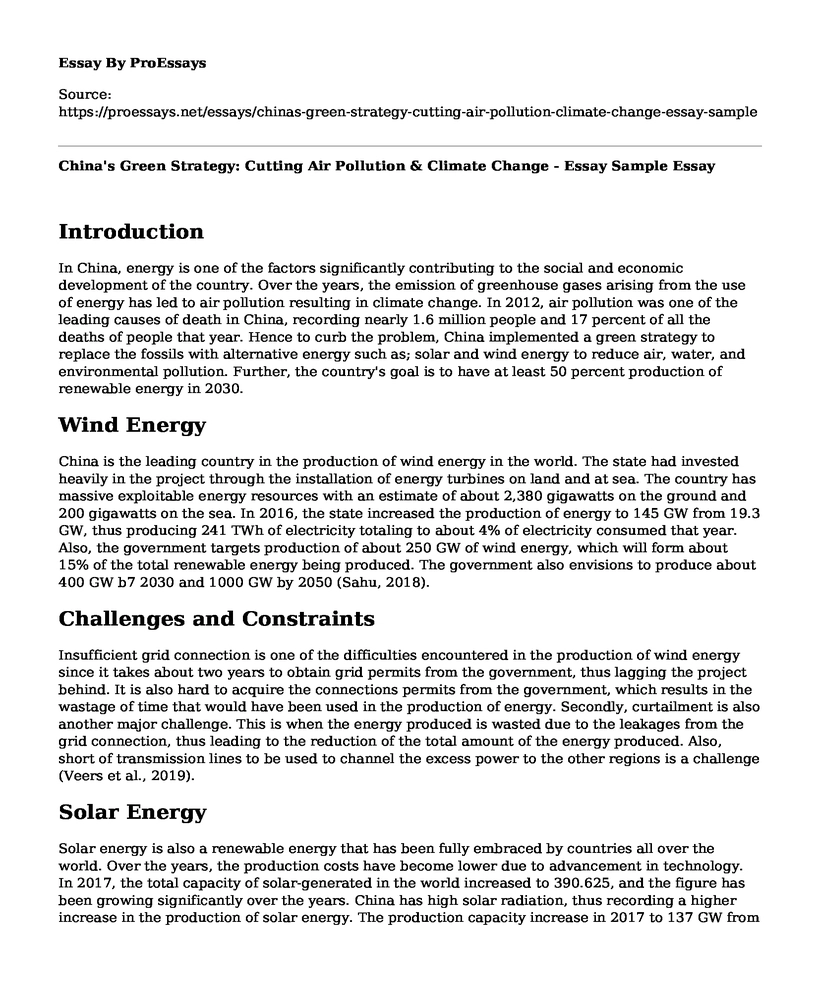Introduction
In China, energy is one of the factors significantly contributing to the social and economic development of the country. Over the years, the emission of greenhouse gases arising from the use of energy has led to air pollution resulting in climate change. In 2012, air pollution was one of the leading causes of death in China, recording nearly 1.6 million people and 17 percent of all the deaths of people that year. Hence to curb the problem, China implemented a green strategy to replace the fossils with alternative energy such as; solar and wind energy to reduce air, water, and environmental pollution. Further, the country's goal is to have at least 50 percent production of renewable energy in 2030.
Wind Energy
China is the leading country in the production of wind energy in the world. The state had invested heavily in the project through the installation of energy turbines on land and at sea. The country has massive exploitable energy resources with an estimate of about 2,380 gigawatts on the ground and 200 gigawatts on the sea. In 2016, the state increased the production of energy to 145 GW from 19.3 GW, thus producing 241 TWh of electricity totaling to about 4% of electricity consumed that year. Also, the government targets production of about 250 GW of wind energy, which will form about 15% of the total renewable energy being produced. The government also envisions to produce about 400 GW b7 2030 and 1000 GW by 2050 (Sahu, 2018).
Challenges and Constraints
Insufficient grid connection is one of the difficulties encountered in the production of wind energy since it takes about two years to obtain grid permits from the government, thus lagging the project behind. It is also hard to acquire the connections permits from the government, which results in the wastage of time that would have been used in the production of energy. Secondly, curtailment is also another major challenge. This is when the energy produced is wasted due to the leakages from the grid connection, thus leading to the reduction of the total amount of the energy produced. Also, short of transmission lines to be used to channel the excess power to the other regions is a challenge (Veers et al., 2019).
Solar Energy
Solar energy is also a renewable energy that has been fully embraced by countries all over the world. Over the years, the production costs have become lower due to advancement in technology. In 2017, the total capacity of solar-generated in the world increased to 390.625, and the figure has been growing significantly over the years. China has high solar radiation, thus recording a higher increase in the production of solar energy. The production capacity increase in 2017 to 137 GW from the initial 95 GW in 2015. The government has supported the project by subsiding solar system, thus making them affordable to everyone. This has significantly led to a decrease in the production cost resulting in efficiency and an increase in production. The government has also offered tax incentives to all the solar stations and distributions centers, thus attracting private investors from all over the globe (Tang, et al., 2018).
Solar Energy Constraints in Hong Kong
Although the production of solar energy is popular in China, cities such as Hong Kong have been reluctant in the adaptation of solar energy. The high cost of production is one of the factors that has significantly contributed to reluctance. The limitation of the grid also leads to a delay in the creation of solar energy. This is because the parties responsible for issuing the permits have little knowledge about the grid. The residents of the city have also not fully embraced the new energy, thus leading to low energy being produced. The city is also very congested and lacks enough space to be used in the production of solar energy (Mah et al., 2018).
References
Mah, D. N. Y., Wang, G., Lo, K., Leung, M. K., Hills, P., & Lo, A. Y. (2018). Barriers and policy enablers for solar photovoltaics (PV) in cities: Perspectives of potential adopters in Hong Kong. Renewable and Sustainable Energy Reviews, 92, 921-936.
Sahu, B. K. (2018). Wind energy developments and policies in China: A short review. Renewable and Sustainable energy reviews, 81, 1393-1405.
Tang, N., Zhang, Y., Niu, Y., & Du, X. (2018). Solar energy curtailment in China: Status quo, reasons and solutions. Renewable and Sustainable Energy Reviews, 97, 509-528.
Veers, P., Dykes, K., Lantz, E., Barth, S., Bottasso, C. L., Carlson, O., ... & Laird, D. (2019). Grand challenges in the science of wind energy. Science, 366(6464), eaau2027.
Cite this page
China's Green Strategy: Cutting Air Pollution & Climate Change - Essay Sample. (2023, Apr 24). Retrieved from https://proessays.net/essays/chinas-green-strategy-cutting-air-pollution-climate-change-essay-sample
If you are the original author of this essay and no longer wish to have it published on the ProEssays website, please click below to request its removal:
- Coal Mining in Appalachia
- How Robotics Will Change Our Lives - Essay Sample
- Essay Sample on the Benefits of Nuclear Power Plants Outweigh the Potential Harmful Applications
- Public Health After Natural Disasters: A Case Study of Pakistan Flood 2010
- Paper Example on California's Water Crisis: Drought, Urbanization and Loss of Wetland
- Essay Example on Light Pollution: Effects On Health, Ecosystems, and Astronomy
- Paper Sample on Meat Production: Feed-Lots vs. Grass-Fed - Ecological vs. Unnatural







